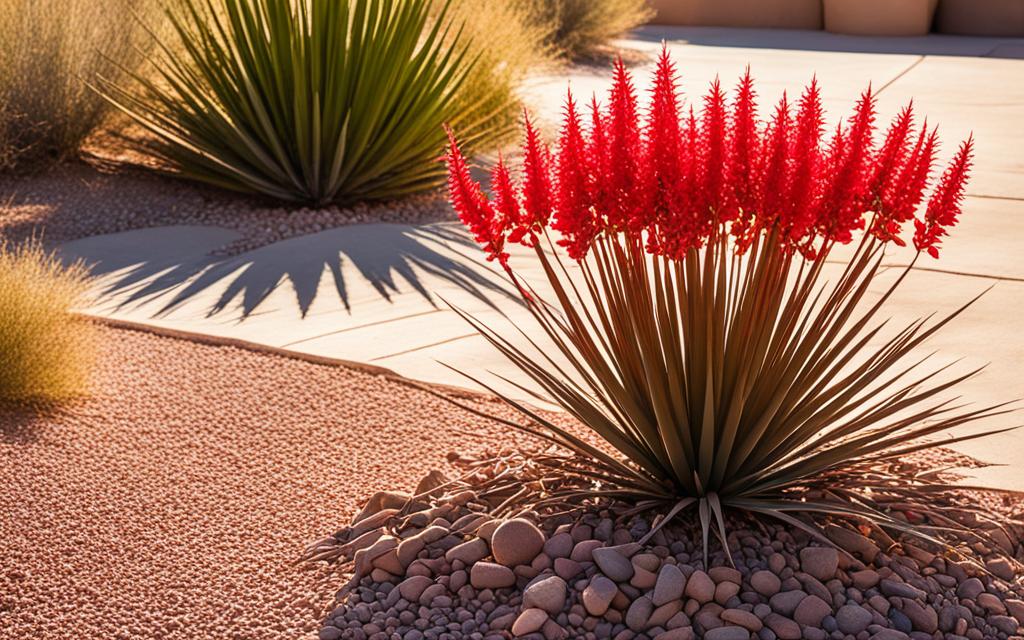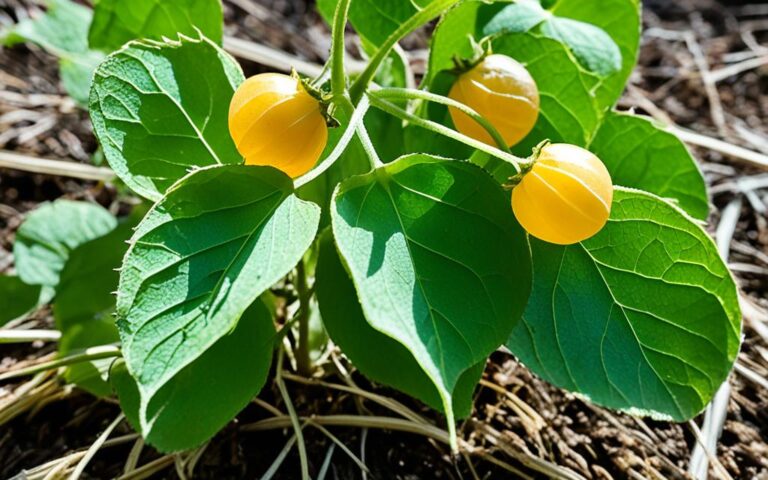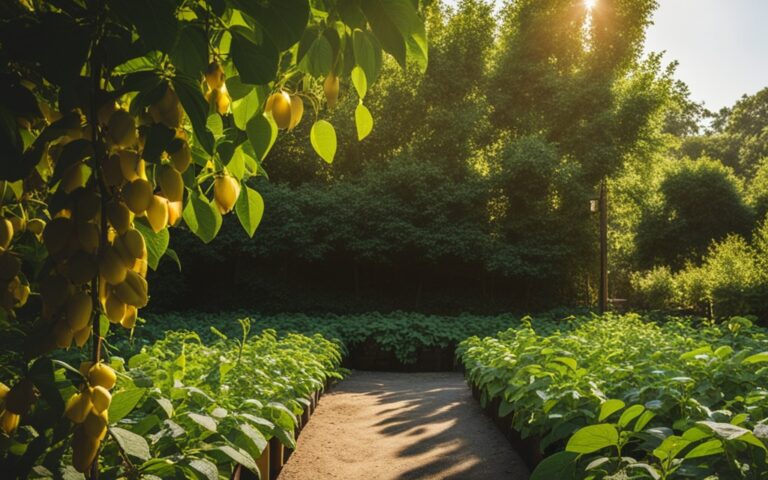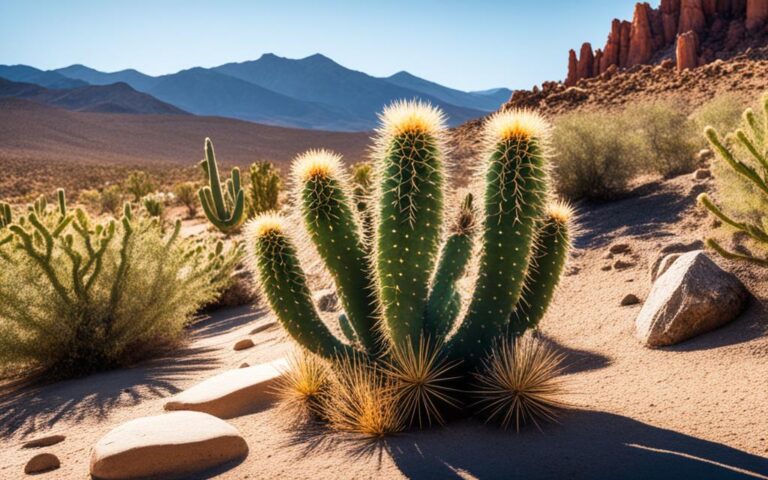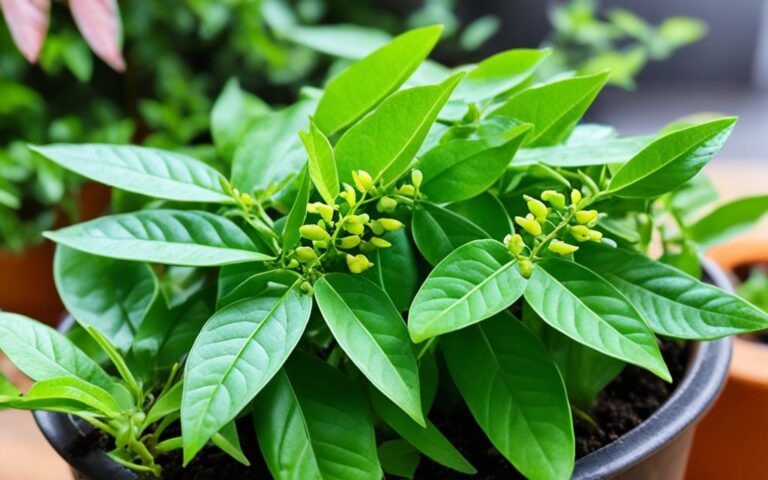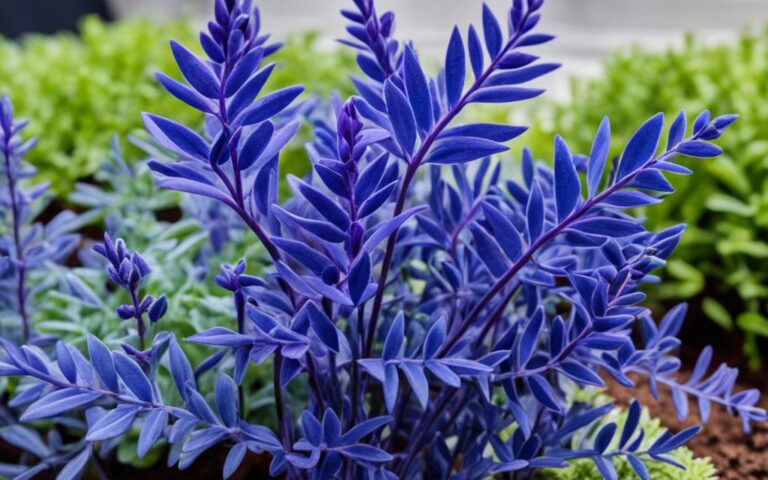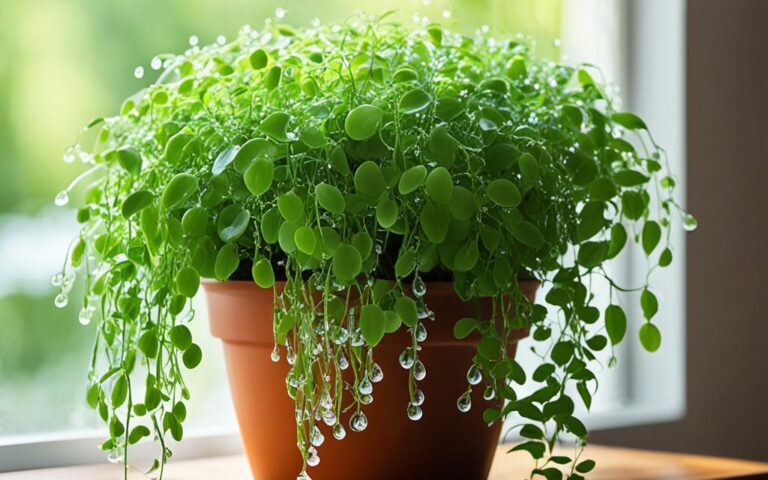Red Yucca Plant: Hardy Desert Beauty for Your Garden
Imagine a plant that can handle the toughest desert weather and still look amazing. Meet the red yucca (Hesperaloe parviflora), a tough succulent that loves the dry southwest. It’s from Texas and is perfect for gardens that need little water. This plant brings beauty all year, needs little care, and draws in hummingbirds and butterflies.
Key Takeaways
- The red yucca plant is a stunning, drought-tolerant succulent native to Texas.
- It blooms with vibrant, spike-like red flowers from May through September.
- Red yucca is incredibly hardy, withstanding temperatures as low as -20 degrees Fahrenheit.
- This low-maintenance plant thrives in full sun and well-drained soil, making it a perfect choice for xeriscaping and low-water gardens.
- Red yucca’s nectar-rich blooms attract hummingbirds and butterflies, adding to its appeal as a landscaping gem.
Introducing the Captivating Red Yucca Plant
The red yucca plant, or Hesperaloe parviflora, is a beautiful succulent from the southwestern United States. It’s not a true yucca but part of the Asparagaceae family. It has long, leaf-like blades and bright red or pink flowers that bloom from spring to fall. This makes it a great choice for desert gardens.
This red yucca plant grows well in USDA zones 5-11. It can get 3 to 5 feet tall and spread 5 to 6 feet wide. Its leaves stay green all year and grow in a whorled pattern. It’s slow-growing and can handle drought, making it easy to care for.
The hesperaloe parviflora, or red yucca, has bright flowers in coral and salmon colors. These flowers bloom in the spring, summer, and fall. They draw in pollinators and make the southwest native plant a great choice for gardens.
“The red yucca is a true gem of the Southwest, captivating gardeners and nature lovers alike with its striking foliage and fiery blooms.”
The red yucca is perfect for gardeners who want desert beauty in their gardens. It’s tough, doesn’t need much water, and is easy to care for. Its unique look and adaptability make it a favorite among native plants, sure to delight for many years.
What Makes Red Yucca a Standout?
The red yucca plant, known as Hesperaloe parviflora, shines in southwestern gardens. It’s a top pick for drought-tolerant and low-maintenance plants in dry landscapes.
Drought Tolerance
Red yucca is loved for its drought tolerance. This succulent does well in dry conditions and needs little water once it’s grown. It’s perfect for gardeners who want to save water and for xeriscaping projects.
Low Maintenance
Keeping a garden looking great can be hard, but red yucca makes it easy. This low-maintenance plant only needs the occasional trim of dead flower stalks. It’s a favorite among busy people and gardening beginners for its beauty with little effort.
Year-Round Beauty
Red yucca’s evergreen foliage looks good all year, adding beauty to your garden. Its flowers, in colors like coral to deep red, bloom from spring to fall. This means your garden will always have color and interest.
“The red yucca’s drought tolerance, low-maintenance nature, and year-round beauty make it a true gem in southwestern gardens.”
The Allure of Red Yucca’s Blooms
Gardeners love the red yucca plant for its beautiful flowers. It has tall flower stalks that can grow up to 5 feet high. These stalks are covered with bright red or pink bell-shaped blooms. These flowers are full of nectar and attract many pollinators, making it great for hummingbird-friendly plants and pollinator gardens.
Fiery Red Flower Spikes
Red yucca blooms from spring to autumn. Each flower stalk can grow up to 5 feet tall. The flowers are about 2 inches long and come in bright colors like pink, red, and orange. They make a beautiful sight in any garden.
Attracting Pollinators
- Hummingbirds visit red yucca from spring to fall because of its nectar-rich flowers.
- Butterflies and moths also enjoy the red yucca’s long blooming season, making it a great choice for pollinator gardens.
- To keep red yucca looking good, just cut off dead flower stalks in the fall.
“Red yucca, with its striking flowers and adaptability to drought, is a true desert treasure that deserves a place in any Southwestern garden.”
Red Yucca Plant: A Versatile Landscaping Gem
The red yucca (Hesperaloe parviflora) is more than just beautiful. It’s a versatile plant that can improve many landscape designs. It’s perfect for a desert-inspired garden, adding beauty to a rock garden, or as a focal point. Its unique shape and bright color make it a great choice.
This plant is known for its drought tolerance. It’s ideal for xeriscaping because it needs little water. It loves the sun and blooms from late spring to summer. The fiery red flower spikes it produces attract hummingbirds and butterflies.
The red yucca fits well in many places, from business properties to home gardens. Its beauty and easy care make it a top pick for landscaping with red yucca. It can make any desert-inspired garden or rock garden accent look better.
| Characteristic | Red Yucca |
|---|---|
| Bloom Time | Late spring through summer |
| Pollinator Attraction | Hummingbirds and butterflies |
| Drought Tolerance | Excellent |
| Sunlight Requirement | Full sun |
| Height | 3-4 feet |
| Spread | 4-6 feet |
| USDA Hardiness Zones | 6-10 |
The red yucca is a true gem for landscaping with red yucca. It’s adaptable and easy to care for. It’s perfect for creating beautiful desert-inspired gardens and rock garden accents.
The Desert-Friendly Nature of Red Yucca
Red yucca (Hesperaloe parviflora) shines in dry lands, perfect for those who love water-saving gardens. It’s from the Chihuahuan desert in southwest Texas and northern Mexico. This tough plant has grown to live well in dry times.
Thriving in Arid Conditions
This plant has deep roots and thick leaves, ready for the desert’s heat and little rain. Once it’s settled, it needs little water, saving water for other uses. It’s strong against pests and diseases, great for desert gardens.
Xeriscaping Perfection
Red yucca is perfect for xeriscaping, a style that uses plants that don’t need much water. Adding it to your garden makes it look great with less water. It’s a smart choice for anyone wanting a beautiful, water-saving yard.
“Red yucca is a low-maintenance succulent that thrives in hot, dry climates, making it a top choice for xeriscaping and water-wise landscaping.”
The Fascinating Biology of Red Yucca
The red yucca (Hesperaloe parviflora) is not a true yucca plant. It’s a hardy succulent in the Asparagaceae family, in the Hesperaloe genus. It stands out because its leaves don’t have the sharp tips of true yuccas.
The red yucca keeps its leaves all year. Most desert plants drop their leaves in hot or cold months. But the red yucca stays green, making it perfect for landscaping.
Not a True Yucca
The red yucca (Hesperaloe parviflora) is not a true yucca. It’s in the Asparagaceae family, Hesperaloe genus. Its leaves don’t have the sharp tips of real yuccas.
Evergreen Foliage
The red yucca is evergreen. Unlike many desert plants, it keeps its leaves all year. This makes it a great choice for landscaping.
“The red yucca is a captivating desert plant that defies expectations with its unique biology and year-round beauty.”
Red Yucca: A Texas Native Treasure
The red yucca, or Hesperaloe parviflora, is a treasured native plant of Texas. It grows naturally in the southwestern parts of the state. This hardy succulent has thrived for centuries in the hot, dry conditions of the region.
As a Texas native plant, it’s a great choice for gardeners and landscapers. They can use it to add regionally appropriate and ecologically beneficial species to their designs.
The southwestern native plant red yucca stands out with its vibrant red flowers. These flowers rise from the plant’s base, offering a bold display. This not only makes the garden look great but also attracts pollinators like hummingbirds and butterflies.
This makes it a key part of the local ecosystem. The Hesperaloe parviflora native range covers much of west Texas. It’s a staple in many xeriscape and native plant gardens.
Its ability to grow well in different soils makes it perfect for both home and business landscapes. It adds desert elegance and natural beauty to any space.
For both experienced and new gardeners, the red yucca is a must-have in Texas landscapes. Its hardiness, beautiful blooms, and ecological benefits make it a true Texas native treasure. It will continue to enchant and delight for many years.
Growing and Caring for Red Yucca
Growing the red yucca (Hesperaloe parviflora) in your garden needs the right care and conditions. This desert plant loves the hot, dry areas of the southwestern United States. It’s perfect for those who want a low-care and water-saving plant for their garden.
Ideal Growing Conditions
Red yucca plants do best in full sun and soil that drains well. They can go without much water once they’re settled. This tough plant can live in USDA hardiness Zones 6-13, and even in some protected spots in Zone 5b.
Maintenance Tips
- Prune spent flower stalks in late summer or early fall, after the blooms have faded.
- Avoid cutting the top of the plant to maintain its attractive appearance and support healthy growth.
- Use clean, sharp pruning shears and wear protective gear like gloves and eyewear during the pruning process.
- Properly sanitize pruning tools before and after use to prevent the potential spread of diseases.
- Prune conservatively, starting with small amounts and adjusting as needed to ensure the plant’s well-being and aesthetics.
Red yucca is great for gardeners who want to save water. With the right care and these tips, you can enjoy its beauty for many years.
| Red Yucca Cultivation Facts | Details |
|---|---|
| USDA Hardiness Zones | 6-13, and perhaps protected locations in Zone 5b |
| Soil Requirements | Well-drained, tolerant of a variety of soil types |
| Sunlight Needs | Full sun |
| Water Requirements | Drought-tolerant, minimal watering once established |
| Bloom Time | Spring through summer, with spikes of pink or coral-colored flowers |
| Maintenance | Prune spent flower stalks in late summer or fall |
Stunning Varieties and Cultivars
The classic red yucca (Hesperaloe parviflora) stands out with its bold, fiery blooms. But gardeners can also explore other varieties and cultivars. The yellow yucca is a great choice, with vibrant, golden flowers. It has the same look as the red yucca but in a different color.
The Classic Red Yucca
The original red yucca is a real showstopper. It blooms all summer with fiery red flowers that can reach up to five feet tall. This plant grows over three feet tall and wide, perfect for xeriscaping and desert gardens.
Yellow Yucca: A Vibrant Alternative
For gardeners looking for a vibrant twist, the yellow yucca is a great choice. It has the same look as the red yucca but with a golden flower. This plant attracts pollinators and adds a unique touch to any garden.
| Variety | Flower Color | Height | Width |
|---|---|---|---|
| Brakelights Red | Vivid red | 2 feet | 2 feet |
| Desert Flamenco | Pinkish-orange | 30 inches | 30 inches |
| Desert Dusk | Dark maroon | Upright stalk | Upright stalk |
| Sandia Glow | Watermelon-red | 3 feet | 3 feet |
| Pink Parade | Pink | 3-4 feet | 3-4 feet |
| Yellow Yucca | Golden-hued | 3 feet | 3 feet |
These stunning red yucca varieties and yellow yucca cultivars add diversity and visual interest to gardens.
Red Yucca in Commercial and Residential Landscapes
Red yucca is great for both commercial and residential landscapes. It’s perfect for office parks, hotels, and shopping centers. Its hardy nature and low care needs make it a top pick for eye-catching, sustainable plantings.
At home, people love red yucca for its easy care. It thrives with little attention, adding beauty to gardens without the hassle. Its drought tolerance, bright flowers, and adaptable growth make it a standout in any garden.
| Commercial Red Yucca Plantings | Residential Red Yucca Gardens |
|---|---|
|
|
Red yucca is a top choice for both commercial and residential landscapes. It’s hardy and easy to care for, making it simple for owners to have beautiful, sustainable landscapes with little work.
“Red yucca is the perfect choice for creating a drought-resistant and visually appealing landscape in both commercial and residential settings.”
Companion Plants for Red Yucca
When designing a landscape with red yucca, think about plants that match well with it. These plants are tough and add beauty to your desert garden. They make your garden look great and need little care.
Great plants to pair with red yucca are agave, opuntia cactus, and lavender. They look great with the red yucca and help your garden use less water. This makes your garden perfect for dry areas.
- Tradescantia/Purple Heart
- Helichrysum petiolare/Licorice plant ‘Limelight’
- Lantana camara ‘Samantha’
- Sedum
- Ceratostigma
- Coreopsis
- Grass or Tiger Lilies
- Rudbeckia
- Sage
- Yarrow
These plants add beauty and make your garden easy to care for. By picking and placing them well, you can make a beautiful desert garden. This garden will highlight the red yucca’s beauty.
| Companion Plant | Characteristics |
|---|---|
| Tradescantia/Purple Heart | A trailing succulent with vibrant purple foliage that contrasts beautifully with the red yucca. |
| Helichrysum petiolare/Licorice plant ‘Limelight’ | A drought-tolerant, silver-leaved plant that adds a soft, textural element to the landscape. |
| Lantana camara ‘Samantha’ | A compact, mounding lantana with bright, multi-colored flowers that bloom from spring to frost. |
| Sedum | A diverse genus of succulent plants that thrive in arid conditions and complement the red yucca’s form. |
| Ceratostigma | A low-growing, spreading plant with vibrant blue flowers that bloom in late summer and fall. |
| Coreopsis | A cheerful, drought-tolerant perennial with daisy-like flowers in shades of yellow and orange. |
Adding these plants makes your desert garden beautiful and peaceful. It will show off the red yucca’s beauty.
Propagating Red Yucca: A Sustainable Approach
For gardeners looking for a sustainable way to grow red yucca, propagation is key. This tough succulent can be easily spread through different methods. This lets you grow more plants and share red yucca with others.
Division: Separating Offsets for New Growth
Dividing is a great way to spread red yucca. Look for the plant’s offsets or “pups” and gently take them away from the main plant. Make sure each offset has roots attached. Then, plant these in soil that drains well to get new red yucca plants.
Seed Propagation: Sowing for Success
You can also grow red yucca from seeds. Wait for the seed pods to ripen, then collect them. Plant the seeds in soil that drains well. With time and care, these seeds will sprout and become new red yucca plants.
Using division and seed methods are great ways to spread red yucca. These methods help you enjoy this drought-resistant and easy-care plant for many years. By choosing these sustainable ways to grow, you can keep your garden beautiful with red yucca.
Reviving Overgrown Red Yucca Plants
The red yucca plant is tough and can survive with little water. But, they can get too big and need some care. Gardeners have ways to manage overgrown red yucca and rejuvenate red yucca plants. This keeps them looking great and healthy.
One good way is to take out the old, big red yucca plant and put in a new, smaller one. This gives the plant a new start and keeps it looking nice. Or, you can divide the overgrown plant. This means you take a part of it and plant it somewhere else to make a new red yucca.
Keeping up with red yucca maintenance stops them from getting too big. Watch your red yucca plants in early spring for any signs they’re getting too big or looking sick. Cutting off dead leaves and flower stalks helps them stay nice.
| Rejuvenation Technique | Benefits | Considerations |
|---|---|---|
| Removing and Replacing Overgrown Plant |
|
|
| Dividing Overgrown Plant |
|
|
By taking steps to manage the growth of red yucca plants, gardeners can keep their landscapes looking great. These plants are known for their desert beauty.
Companion Plants for Red Yucca
When designing a landscape with red yucca, picking the right plants is key. Choose drought-tolerant and southwestern-inspired plants to make a desert-themed garden. These plants will highlight the red yucca’s bright colors.
Great choices for red yucca include agave, opuntia cactus, and lavender. They add contrast with their different leaves and flowers. They also make the garden easy to care for and water-wise.
Agave’s bold shapes look great with red yucca’s elegant leaves. Opuntia cactus and lavender add color and fragrance. Their blooms and the red yucca’s flowers make a beautiful display together.
| Companion Plant | Key Characteristics | Complementary Attributes |
|---|---|---|
| Agave | Succulent, architectural foliage | Provides visual contrast with red yucca’s graceful leaves |
| Opuntia Cactus | Vibrant, colorful blooms | Complements the fiery red flower spikes of red yucca |
| Lavender | Fragrant, purple flowers | Creates a harmonious pairing with red yucca’s blooms |
Choosing plants that are drought-tolerant and easy to care for makes a beautiful desert garden. This way, you can show off the red yucca’s beauty in a sustainable landscape.
Conclusion: Embrace the Hardy Desert Beauty
The red yucca plant is a standout in southwestern gardens. It offers a mix of benefits of red yucca, low upkeep, and beauty all year. Its eye-catching flowers, adaptability, and status as a Texas native make it a top choice for gardeners and landscapers. By choosing the red yucca, you can make your outdoor spaces look stunning and save water.
This plant thrives in dry conditions and needs little water, making it great for water-saving gardens. Its ability to handle drought, low care, and beautiful leaves and flowers make it perfect for desert gardens. If you want a lush, green oasis or a touch of the Southwest in your yard, the red yucca is a great pick. It’s reliable, resilient, and will surely impress.
Adding red yucca to your garden means enjoying its beauty and helping save water. This tough desert plant shows nature’s beauty. By choosing it, you make your outdoor space more beautiful and eco-friendly. So, why not bring a bit of the Southwest to your garden and let the red yucca take your landscape to the next level?
